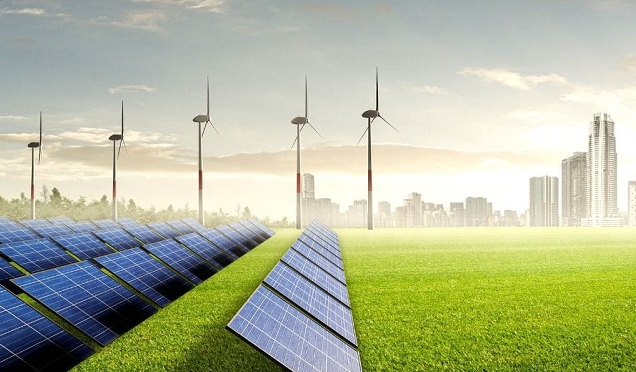“Green Environment” relates to the concerns for environmental conservation and improved health of the environment. This includes supporting practices like informed consumption, conservation practices and investment in renewable energy. By recognizing the balance between humans and various natural eco-systems, we hope to lead by example through changes in our practices, public policy and individual behavior to renew and revitalize our connection with nature.
India’s energy demand is expected to increase more than that of any other country in the coming decades due to its sheer size and enormous potential for growth and development. Therefore, most of this new energy demand must be met by low-carbon, renewable sources. India’s announcement India that it intends to achieve net zero carbon emissions by 2070 and to meet 50% of its electricity needs from renewable sources by 2030 marks a historic point in the global effort to combat climate change.
India was ranked fourth in wind power capacity and solar power capacity, and fourth in renewable energy installed capacity, as of 2023. Installed renewable power generation capacity has increased at a fast pace over the past few years, posting a CAGR of 15.4% between FY16 and FY23. India has 125.15 GW of renewable energy capacity in FY23. India is the market with the fastest growth in renewable electricity, and by 2026, new capacity additions are expected to double.
With the increased support of the government and improved economics, the sector has become attractive from an investor’s perspective. As India looks to meet its energy demand on its own, which is expected to reach 15,820 TWh by 2040, renewable energy is set to play an important role.
India is all set for transformative and multi-dimensional growth of clean and renewable energy sources which is being developed supportively by the government initiatives, technological developments, and investments. In the country’s journey to its ambitious target of reaching net neutrality by 2070, the solar and wind capacities, as well as other renewable energy capacities, are forecasted to witness very rapid growth.
India has recently announced that it is targeting net zero emissions by 2070. Over the last two decades, energy consumption in India has doubled, and the energy use is expected to grow by at least 25% by 2030. India’s energy imports amount to US$90 billion annually which is almost 40% of its primary energy. These facts raise the criticality of using renewable energy sources to reduce the consequence of relying on non-renewable resources.
Energy sector in India is going through profound transformation, where it is progressively shifting away from fossil fuels and welcoming renewable energy sources. In 2022-23, the utility’s installed capacity of RES (excluding hydro) grew by 12.20% while that of thermal sources grew by 0.49%. This trend demonstrates that India is changing its energy patterns with renewables accumulating more weight across the nation’s electricity system.
As of March 2024, the thermal power generation capacity accounted for 56% of Installed electricity generation capacity in India, while renewable energy sources (RES) and hydroelectric power accounted for 32% and 11%, respectively. The contribution of nuclear power to the total installed capacity was only 2%.
The proportion of thermal-based generation capacity in the overall installed capacity has seen a decrease from 63.3% in 2008-09 to 56% in 2023-24. Simultaneously, the share of hydro-based generation capacity also diminished from 25% to 11%, while the capacity from renewables experienced a significant rise from 8.9% to 32%. From 2009 to 2023, CAGR of the total installed electricity generation capacity was approximately 7.7% in contrast to 17.4% for RES and 5.7% for all other sources.
Energy sector in India is going through profound transformation, where it is progressively shifting away from fossil fuels and welcoming renewable energy sources. In 2022-23, the utility’s installed capacity of RES (excluding hydro) grew by 12.20% while that of thermal sources grew by 0.49%. This trend demonstrates that India is changing its energy patterns with renewables accumulating more weight across the nation’s electricity system.
India aims to achieve a 20% blend of ethanol in petrol by 2025-26. This requires approximately 1,016 crore litres of ethanol to be utilized to replace an equivalent amount of petrol. Considering both blending applications and others, a total demand for ethanol is estimated at 1,350 crore litres to meet the target of blending 20% by 2025. If the operational efficiency of the production is at 80%, then by 2025, the consumption of motor spirit should be around 1.7 billion litres. This estimate takes into consideration the projected increase in petrol demand from two-wheelers and passenger cars as well as the expected sales of motor spirit.
National Green Hydrogen Mission: This mission was approved in January 2023 with a financial outlay of US$ 2.4 billion. The budget allocation includes US$ 2.1 billion (Rs. 17,490 crore) for the SIGHT programme, US$ 175.9 million (Rs. 1,466 crore) for pilot projects, US$ 48 million (Rs. 400 crore) for research and development, and US$ 46.6 million (Rs. 388 crore) for miscellaneous components.
At US$ 2.1 billion, majority of the budget has been assigned for the Strategic Interventions for Green Hydrogen Transition (SIGHT) programme, a programme supporting the domestic manufacturing of electrolysers and the production of green hydrogen. The SIGHT programme will operate under Mode-2B, a framework devised by the MNRE that centralises demand and engages in competitive bidding to secure the most cost-effective supply of green hydrogen and its derivatives. The first tranche of Mode-2B aims for a bidding capacity of 200,000 million tonnes annually. India’s strategy under this mission is to become a competitive exporter of green hydrogen, targeting a share of the anticipated global demand of 200 million tonnes by 2030.
Green practices or initiatives are things that businesses do to reduce their environmental impact, like reducing energy consumption, using eco-friendly materials, promoting sustainable transport, and reducing waste. Green practices help to address urgent environmental challenges like climate change, pollution, and the overuse of natural resources.
Many businesses have adopted green initiatives as part of their CSR objectives to show that they’re taking steps to minimise their negative environmental impact and contribute to a more sustainable future. Green practices can benefit organisations by lowering costs, improving efficiency, and promoting a positive public image. They also demonstrate a commitment to ethical business practices, which can help to build trust with customers and stakeholders.
The principle or concept of a green environment covers several points, including supporting the use of renewable materials, applying sustainable consumption and production, minimizing waste, and reducing toxic pollutants (land, water and soil).
Furthermore, the main objective of implementing these practices is saving the earth by preventing the exploitation of natural resources and preserving the environment. Several other concepts support a green environment, such as green chemistry, green economy, green tourism, and green energy. All three works together to fight climate change and slow down the effects of global warming.
(The author can be mailed at: [email protected]. X/Twitter: @haniefmha)








